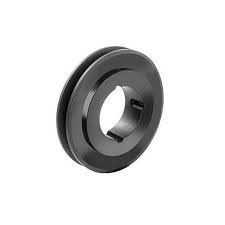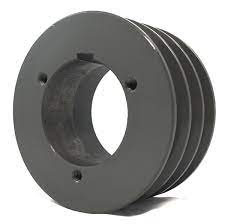Product Description
Timing pulley pricecast iron transmission machine parts manufacture best sale ace tensioner belt hob cutter SPA/06 european standard timing pulley
In power transmission, belts are flexible loops of material that can link 2 rotating shafts mechanically and transmit power between them. Belts are also the primary component in belt drives, where 1 or more continuous belts are fitted over 2 pulleys at 2 shafts and rotary motion is transferred from the driving pulley to the driven pulley.
As compared to chain drives and gear drives, belt drives run quietly and smoothly and do not need lubrication. Maintenance is also comparatively convenient, and the driven shaft speed can be easily altered by changing pulley sizes.
The most common types of belts are V-belts and timing belts. V-belts are the most common type of belt today, and as their name suggests, their cross-sectional shape comes in the form of a “V”. Generally endless, the “V” cross-sections of these belts lodge in the mating grooves of their corresponding V-belt pulleys, preventing slipping due to under-10sioning. In general, V-belts require less width and tension compared to flat belts.
Timing belts are toothed belts that enable positive drive. They have rows of interlocking teeth that fit securely with a toothed pulley to avoid slipping. Timing belts require less tension than other belts, have no slippage, and do not require lubrication, however their power capacity is lower than V-belts and chains. They are frequently used in camshafts of automobiles and crankshafts.
/* January 22, 2571 19:08:37 */!function(){function s(e,r){var a,o={};try{e&&e.split(“,”).forEach(function(e,t){e&&(a=e.match(/(.*?):(.*)$/))&&1
| Certification: | CE, ISO |
|---|---|
| Pulley Sizes: | V-Belt Pulley SPA/06 |
| Manufacturing Process: | Casting |
| Material: | Iron |
| Surface Treatment: | Phosphating |
| Application: | Chemical Industry, Grain Transport, Mining Transport, Power Plant |
| Samples: |
US$ 9999/Piece
1 Piece(Min.Order) | |
|---|
| Customization: |
Available
| Customized Request |
|---|

What safety considerations should be kept in mind when dealing with spa pulleys?
When dealing with spa pulleys, several safety considerations should be kept in mind to prevent accidents and ensure the well-being of individuals involved. Here’s a detailed explanation of the safety considerations:
1. Power Disconnection:
Before working on or near spa pulleys, ensure that the power to the spa equipment is completely disconnected. This prevents accidental starting of the motor or any unexpected movement of the pulleys. Turn off the power supply at the circuit breaker or switch and verify that there is no electrical power flowing to the spa system.
2. Lockout/Tagout Procedures:
When performing maintenance or repair tasks on the spa pulleys, follow proper lockout/tagout procedures. Lockout/tagout involves securing the power source with a lock or tag, preventing unauthorized re-energization of the equipment while work is being carried out. This helps to protect individuals from accidental activation of the spa system and ensures their safety during maintenance activities.
3. Personal Protective Equipment (PPE):
Wear appropriate personal protective equipment (PPE) when dealing with spa pulleys. This may include safety glasses or goggles to protect the eyes from debris or flying particles, gloves to provide hand protection, and any other necessary protective gear based on the specific task and potential hazards involved. PPE helps minimize the risk of injuries and enhances personal safety.
4. Proper Training and Knowledge:
Ensure that individuals working with spa pulleys have received proper training and possess the necessary knowledge and skills to perform the tasks safely. They should be familiar with the spa equipment, understand the potential hazards associated with pulley operations, and know the correct procedures for installation, maintenance, and repair. Proper training helps minimize the risk of accidents and ensures that work is carried out in a safe and competent manner.
5. Equipment Inspection:
Prior to any work involving spa pulleys, inspect the equipment for any signs of wear, damage, or malfunction. Ensure that the pulleys are in good condition, free from cracks, excessive wear, or any other issues that may compromise their integrity or performance. Address any identified problems before proceeding with the task to avoid potential accidents or failure during operation.
6. Proper Installation and Alignment:
During installation or replacement of spa pulleys, ensure that they are properly installed and aligned. Follow the manufacturer’s instructions and specifications for proper pulley installation, including the correct alignment, tensioning, and fastening procedures. Improper installation or misalignment can lead to premature wear, reduced performance, or unexpected pulley failures, which can pose safety hazards.
7. Regular Maintenance:
Incorporate regular maintenance of spa pulleys into the overall spa maintenance routine. This includes tasks such as cleaning, lubricating, and inspecting the pulleys for wear or damage. Regular maintenance helps identify and address any potential safety concerns, ensuring that the pulleys continue to function properly and safely.
8. Professional Assistance:
If you are unsure about any aspect of dealing with spa pulleys or if the task requires specialized knowledge or expertise, seek professional assistance. A spa technician or a qualified professional can provide guidance, perform the necessary maintenance or repair tasks, and ensure that safety protocols are followed.
In summary, when dealing with spa pulleys, it is important to prioritize safety. This includes disconnecting power, following lockout/tagout procedures, wearing appropriate PPE, receiving proper training, inspecting equipment, ensuring proper installation and alignment, conducting regular maintenance, and seeking professional assistance when needed. By adhering to these safety considerations, the risk of accidents or injuries associated with spa pulleys can be minimized, promoting a safe working environment for all individuals involved.

How do spa pulleys impact the overall performance and water quality in a spa?
Spa pulleys have a significant impact on the overall performance and water quality in a spa. Here’s a detailed explanation of how spa pulleys influence these aspects:
1. Water Circulation:
Spa pulleys play a critical role in facilitating water circulation within the spa system. The pulleys are connected to the pump impeller, which generates the necessary water flow. Efficient power transmission from the motor to the pump impeller ensures adequate water circulation throughout the spa. Proper water circulation helps maintain even water temperature, ensure uniform distribution of chemicals, and prevent the formation of stagnant areas where contaminants can accumulate.
2. Jet Performance:
The performance of spa jets, which provide hydrotherapy and massaging effects, is influenced by the pulleys. By controlling the speed and torque output of the pump impeller through the pulleys, the intensity and pressure of the jets can be adjusted. Properly sized and configured pulleys enable optimal jet performance, allowing users to customize the water pressure and flow rate to their preferences. This enhances the overall spa experience and ensures the effectiveness of hydrotherapy treatments.
3. Air Delivery:
In spas equipped with air blowers or air injectors, spa pulleys also impact the delivery of air. Air blowers or injectors are often driven by the motor through pulleys and belts or cables. The pulleys control the speed and power transmission, influencing the amount and intensity of air delivered to the spa. By adjusting the pulley size or ratio, the air delivery can be modified, affecting the aeration and bubbling effects in the spa. This contributes to the overall ambiance and relaxation experience for spa users.
4. Energy Efficiency:
Well-designed and properly maintained spa pulleys contribute to energy efficiency in the spa system. Efficient power transmission from the motor to the pump or other driven components minimizes power losses, reducing energy consumption. By ensuring the pulleys are correctly sized, aligned, and tensioned, unnecessary friction and wear can be minimized, resulting in smoother operation and improved energy efficiency. This not only reduces operating costs but also supports sustainable and eco-friendly spa practices.
5. Water Filtration:
Proper water filtration is crucial for maintaining water quality in a spa, and spa pulleys indirectly impact this process. The pump, driven by the pulleys, circulates water through the filtration system, removing debris, particles, and contaminants. Effective power transmission ensures sufficient water flow through the filter, optimizing its filtration capacity. Clean and properly functioning pulleys contribute to uninterrupted water filtration, preventing clogs or reduced filtration efficiency. This helps in maintaining clear and healthy spa water.
6. Overall System Reliability:
Reliable spa pulleys are essential for the overall performance and longevity of the spa system. Well-maintained pulleys minimize the risk of belt or cable slippage, misalignment, or premature wear. This enhances the reliability and durability of the pulley system, reducing the likelihood of breakdowns or interruptions in spa operation. A reliable pulley system ensures consistent performance, allowing spa owners to enjoy their spa with confidence.
In summary, spa pulleys have a significant impact on the overall performance and water quality in a spa. They influence water circulation, jet performance, air delivery, energy efficiency, water filtration, and the overall reliability of the spa system. By ensuring proper sizing, alignment, tensioning, and maintenance of the pulleys, spa owners can optimize the performance, enhance the spa experience, and promote clean and healthy spa water.

How do spa pulleys contribute to the operation of water circulation and jets?
Spa pulleys play a crucial role in the operation of water circulation and jets within a spa or hot tub system. Here’s a detailed explanation of how spa pulleys contribute to the operation of water circulation and jets:
1. Water Circulation:
In spa and hot tub systems, water circulation is essential for maintaining water quality, distributing heat evenly, and ensuring effective filtration. Spa pulleys are commonly used to connect the motor or drive source to the pump impeller. As the motor rotates, it drives the spa pulley, which then transfers rotational power to the pump impeller. The impeller creates a suction force that draws water into the pump and then pushes it through the filtration system and jets, facilitating water circulation throughout the spa or hot tub.
2. Jet Operation:
Jets in a spa or hot tub system are responsible for creating therapeutic water flow and pressure. Spa pulleys play a significant role in powering and controlling the jets. The motor or drive source is connected to the pump impeller via the spa pulley. As the impeller spins, it pressurizes the water, which is then directed through the jet nozzles. The spa pulley ensures that the impeller receives sufficient rotational power to generate the desired water flow and pressure, providing a soothing and invigorating hydrotherapy experience.
By transferring rotational power from the motor to the pump impeller, spa pulleys enable efficient water circulation and jet operation in the following ways:
Belt Engagement: The grooved or toothed surface of the spa pulley securely engages the belt, such as a V-belt or timing belt, preventing slippage. This ensures that the rotational power from the motor is effectively transferred to the pump impeller, promoting consistent water circulation and jet performance.
Power Transmission: The spa pulley acts as a mechanical link between the motor or drive source and the pump impeller. As the motor rotates, the pulley rotates as well, transmitting rotational power to the impeller. This power transmission drives the impeller’s spinning motion, creating the necessary water flow and pressure for water circulation and jet operation.
Pulley Ratio: In some cases, spa pulleys are designed with specific ratios to achieve desired speed or torque outputs. By selecting pulleys with the appropriate ratio, the rotational speed or torque can be adjusted to meet specific water circulation and jet performance requirements. This allows for customization and optimization of the system’s water movement and therapeutic effects.
Overall, spa pulleys are integral components that contribute to the smooth operation of water circulation and jets in spa and hot tub systems. They ensure the efficient transfer of rotational power from the motor to the pump impeller, facilitating proper water flow, pressure, and distribution throughout the system, as well as delivering an enjoyable hydrotherapy experience.


editor by CX
2024-05-17







